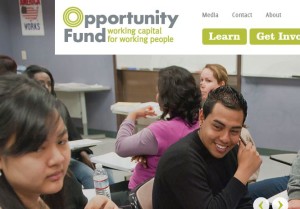Thanks to Susan Brown, CAMEO’s microloan consultant for this post.
 For Opportunity Fund, the desire for meaningful community impact means a commitment to scale.
For Opportunity Fund, the desire for meaningful community impact means a commitment to scale.
- They close 1,500 loans per year, adding up to $26.5 million.
- To date, they have lent $100 million to 4,000 clients who have a median income of $28,000.
- They close about 45 deals per staff per year at a cost of $3,400 per loan, that’s with little automation for risk assessment or underwriting.
- They serve all of California, with offices in Los Angeles, San Francisco and San Jose.
- Their loan consultants (read: officers) are mostly home-based and spend 75% of their time in the field, finding deals and working with potential borrowers.
- They are competing with the merchant cash (MCA) advance industry with their Easy Pay loan product, which, unlike MCA lenders, is structured to support business success.
- In the next five years they plan to invest in $100 million microloans!
These numbers are impressive and set them apart from the rest of their CDFI peers in California.
How are they doing it?
Let’s start with their commitment to a sales culture. Twenty five to forty percent of loan consultant compensation is tied to loan closings and portfolio performance. Opportunity Fund intentionally hires staff with a sales background and mentality. “We use incentive compensation to promote sales,” said Eric Weaver, Opportunity Fund Founder and CEO. “Few people will be high producers without financial incentives.”
Second, Opportunity Fund focuses on lending and leaves other services, like training, to partner organizations. Their goal is to reach out to as many borrowers as possible. “We strive to bring working capital to working people,” said Marco Lucioni, OF’s Executive Vice President of Lending. “We achieve impact through scale.”
In 2012 Opportunity Fund merged with Financiera Confianza, founded by Marco, a for-profit lending company, several years ago which brought in production-oriented people, infrastructure and culture. “This allowed us to amplify our action radius, offer more competitive rates, write bigger loans and offer major benefits to our clients,” Marco said.
Opportunity Fund offers four products.
- EasyPay loans, which aim to be an affordable alternative to merchant cash advances, with fixed interest rates between 8.5% and 15% and a longer repayment term of up to 3 years.
- Small business loans, which range from $20,000 to $100,000 at interest rates between 8.5% and 12%, with up to five-year repayment terms and no early repayment penalty.
- Opportunity Loans range from $2,600 to $20,000 and are suited for inventory, equipment and vehicle purchases. Rates are 8.5% to 18%, with up to two-year repayment terms and no early repayment penalty.
- Equipment and vehicle financing, like loans for food trucks, taxis, limos, fleet vehicles and vans. Focusing on vehicle financing, a market that Opportunity Fund identified as having scalability, is also part of their growth strategy.
The Easy Pay product is another feature that sets Opportunity Fund apart in the CDFI industry. The loan is repaid by automatically deducting a small share of daily credit- and debit-card sales. It allows Opportunity Fund to take more risk by weighing the cash flow side more heavily. Through underwriting Opportunity Fund ensures that no more than 10 percent of a business’ revenues go to covering debt payments, and provide a payback period of up to 36 months, rather than the average eight month payback period of MCAs. Finally, because EasyPay is structured as a loan rather than as a cash advance, all repayment is reported to the credit bureaus.
Opportunity Fund is clear about their sustainability plan. Sixty percent of the loan program is funded through earned revenue, which Eric sees as increasing modestly over the years.
Our core competence is that we’re trusted to target subsidized credit to underserved small business owners in an efficient way that both policy makers and philanthropists care about. Our goal is not to get 100% cost recovery.
“Were trying to balance efficiency and effectiveness to insure positive community impact,” said Caitlin McShane, Director of Communications. “We don’t price based on what the market can bear. Many customers could and would pay more. We want to make a good impact on the business and the community.”
The Opportunity Fund team is clear that for many of their borrowers this is a business transaction, and not all are aware of or care about Opportunity Fund’s nonprofit mission. Opportunity Fund is competing with many online lenders and want to appear as an attractive business alternative, with all the speed and ease the MCAs offer.
“If you are willing to focus on scale and decide that maximizing impact is your mission,” said Marco, “then any CDFI could do what we do.”
What future innovations does Eric see for the CDFI business lending industry?
Due to technology, the process of lending is getting chopped up into smaller pieces where players are creating expertise and efficiency in one part of the lending process. The current model of one agency doing everything from start to finish may not be the best way to go in the future. CDFIs may want to partner with more efficient organizations to manage parts of the lending process. The more efficient we can be, the better we can attract subsidies to support our work.
